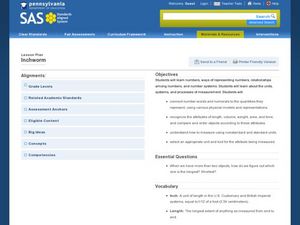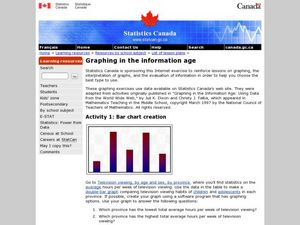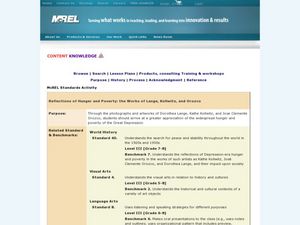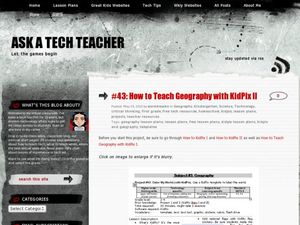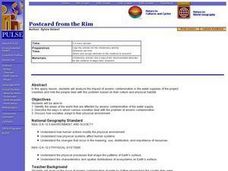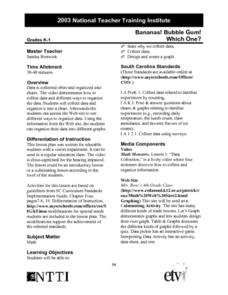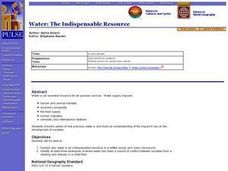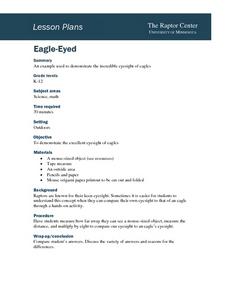Curated OER
Clothesline Sleuth
Sixth graders investigate the origins of clothing production. In this Social Studies lesson, 6th graders examine the components of agriculture involved in making clothes. Students research cotton.
Curated OER
Rights in Conflict
Learners study situations where rights are in conflict. For this conflict in rights lesson, students review a conflict situation and the Supreme Court ruling for the issue. Learners review the Bill of Rights and then receive their own...
Curated OER
Inchworm
Students discover the basic concept of measuring. In this mathematics relationship instructional activity, students identify length, volume, weight, time and area in order to measure different units. Students measure items...
Curated OER
Juliette Low - Founder of the Girl Scouts
Second graders identify the founder of the Girl Scouts Juliette Low. They name reasons as to why clubs are created and brainstorm a list of other clubs they know about. They read the story "The Green Leaf Club News" and discuss why she...
Curated OER
American Indian Reservations
Fifth graders examine life on American Indian reservations, and discuss how confinement on the reservations affected American Indians. They visit the Bureau of Indian Affairs website, and develop positive and negative impact charts about...
Curated OER
Investigation 6 - Dinosaur Extinction
Fourth graders research and analyze theories on why dinosaurs became extinct. They need to find clues as to what the cause may have been. They record the evidence that they find to support their theory on the Dinosaur Extinction Theory...
Curated OER
Fat - A Concentrated Energy Source
High schoolers study fats as a necessary part of a balanced diet. They match foods with visuals showing the amount of fats in each. They compare lunches and how substitutions of various foods can effect the fat content of each meal.
Curated OER
Graphing in the Information Age
Middle schoolers create a variety of graphs based on population data. In this statistics lesson, students use data that can be gathered on-line to make a bar chart, line graph, and circle graph.
Curated OER
Reflections of Hunger and Poverty: the Works of Lange, Kollwitz, and Orozco
Students explore the Great Depression depicted in artwork. In this interdisciplinary lesson plan, students analyze artwork by Dorothea Lange, Kathe Kollwitz, and Jose Clemente Orozco. Students create brochures that feature details...
Curated OER
How to Teach Geography with KidPix II
Students use the computer program KidPix II to color a map of the world. In this world map lesson plan, students fill in different colors for different continents that are told to them on the program KidPix II.
Curated OER
Friends in the Snow
Students practice reading a story in order to develop character recognition skills. They participate in reader's theatre in small groups to increase cooperation and fluency skills.
Curated OER
World Geography: Postcard from the Rim
Students are able to identify the areas of the world that are affected by arsenic contamination of the water supply. They are able to describe the ways in which various societies deal with the problem of arsenic contamination. ...
Curated OER
Naya Nuki's Journey
Students read "Naya Nuki Shoshoni Girl Who Ran" by Kenneth Thomasma. Students chart Naya Nuki's route on a map and identify the navigational signs she used to find her way home. Students also analyze the weather she encounters.
Curated OER
Around The World
Students identify the capitals of the target countries. They locate the target countries on a world map. Students describe one major issue facing the inhabitants of each of the target countries.
Curated OER
Bananas! Bubble Gum! Which One?
Students design and create a graph of data they have collected on their favorite candy bars. They explore how to organize data as well.
Curated OER
Trade Gives Us Access to Things We Wouldn't Otherwise Have
Students work together in groups to research an item related to trade. They decide on an item that they use and determine where it comes from. They track the sources and consumers on a map.
Curated OER
Gaining Familiarity With Haitian Creole
Learners investigate the concept of Haitian Creole. They first fill out a worksheet asking for prior knowledge. Then students compare and contrast the languages of English, French, and Haitian Creole. They define Creole and discuss its...
Curated OER
Planning a Trip to the North Carolina Art Museum
Students navigate the North Carolina Art Museum website and find answers to questions needed before a visit.
Curated OER
World Geography: Water: The Indispensable Resource
Students are able to explain why water is an indispensable resource in a written essay and class discussion. They identify at least three examples of where water has been a source of conflict between societies from a reading and...
Curated OER
Grocery Store Problem Solving
Fourth graders explore healthy eating habits by viewing instructional videos in class. For this food pyramid lesson, 4th graders identify the different classifications within the food pyramid and identify how they can improve overall...
Curated OER
Grocery Store Problem Solving
Third graders practice mathematical problem solving skills. In this problem solving instructional activity, 3rd graders develop mathematical problem solving skills using real-world examples.
Curated OER
Eagle-Eyed
Students study the eyesight of eagles. They discuss raptors and their eyesight and compare it to their own. They measure how far away they can see a small object and its distance. They calculate the eyesight to measure an eagle's...
Curated OER
World Geography: Who am I?
High schoolers are able to provide a basic description of one country that has arsenic in its water supply. They are able to locate these countries on a map. Students explore the majors countries that have been affected by arsenic...
Curated OER
Static Cling
Fifth graders examine the principles of static electricity and positive and negative charges. They observe and then perform experiments with static electricity. They record examples in their journals.


